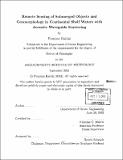| dc.contributor.advisor | Nicholas C. Makris. | en_US |
| dc.contributor.author | Ratilal, Purnima, 1971- | en_US |
| dc.contributor.other | Massachusetts Institute of Technology. Department of Ocean Engineering. | en_US |
| dc.date.accessioned | 2014-11-04T21:32:12Z | |
| dc.date.available | 2014-11-04T21:32:12Z | |
| dc.date.copyright | 2002 | en_US |
| dc.date.issued | 2002 | en_US |
| dc.identifier.uri | http://hdl.handle.net/1721.1/91377 | |
| dc.description | Thesis (Ph. D.)--Massachusetts Institute of Technology, Dept. of Ocean Engineering, 2002. | en_US |
| dc.description | Includes bibliographical references (p. 347-354). | en_US |
| dc.description.abstract | The long range imaging of submerged objects, seafloor and sub-seafloor geomorphology in continental shelf waters using an active sonar system is explored experimentally and theoretically. A unified model for 3-D object scattering and reverberation that takes into account the coupling between propagation and scattering in a stratified medium is developed from wave theory. The conditions necessary for scattering in a waveguide to become diffuse is derived directly from Green's Theorem. Simulations with the unified model indicate that the detection of submerged target echoes above diffuse seafloor reverberation is highly dependent upon waveguide properties, bandwidth, array aperture, measurement geometry, and the scattering properties of the target. Analysis with the unified model shows that it is theoretically plausible for coherent returns from the scattering of evanescent waves by extended but discrete sub-bottom geologic features to stand significantly above diffuse or incoherent returns arising from small-scale roughness of the waveguide boundaries. A long-range bistatic sonar system was deployed in a field experiment and used to image extensive networks of buried river channels and inclined sub-seafloor strata over tens of kilometers in nearreal time. Such a capability is of great advantage in geophysical applications. Since buried river channels are expected to be ubiquitous in continental shelf environments, sub-seafloor geomorphology will play a major role in producing "false alarms" or cluster in long-range sonar systems that search for submerged objects such as underwater vehicles. | en_US |
| dc.description.abstract | (cont.) A generalized extinction theorem for object scattering in a stratified medium is derived that can be applied to detect and classify objects from the total field in the forward scatter direction in a waveguide. Analytic expressions are derived for the attenuation and dispersion in the forward propagated field due to scattering from random surface and volume inhomogeneities in a waveguide. The unified model is applied to show that the active sonar equation is not in general valid for scattering in a waveguide. It is shown that the sonar equation may be made approximately valid in a waveguide by lowering the active frequency of operation sufficiently for the given measurement scenario to simplify analysis for target classification and localization. | en_US |
| dc.description.statementofresponsibility | by Purnima Ratilal. | en_US |
| dc.format.extent | 354 p. | en_US |
| dc.language.iso | eng | en_US |
| dc.publisher | Massachusetts Institute of Technology | en_US |
| dc.rights | M.I.T. theses are protected by copyright. They may be viewed from this source for any purpose, but reproduction or distribution in any format is prohibited without written permission. See provided URL for inquiries about permission. | en_US |
| dc.rights.uri | http://dspace.mit.edu/handle/1721.1/7582 | en_US |
| dc.subject | Ocean Engineering. | en_US |
| dc.title | Remote sensing of submerged objects and geomorphology in continental shelf waters with acoustic waveguide scattering | en_US |
| dc.type | Thesis | en_US |
| dc.description.degree | Ph.D. | en_US |
| dc.contributor.department | Massachusetts Institute of Technology. Department of Ocean Engineering | |
| dc.identifier.oclc | 51928858 | en_US |
